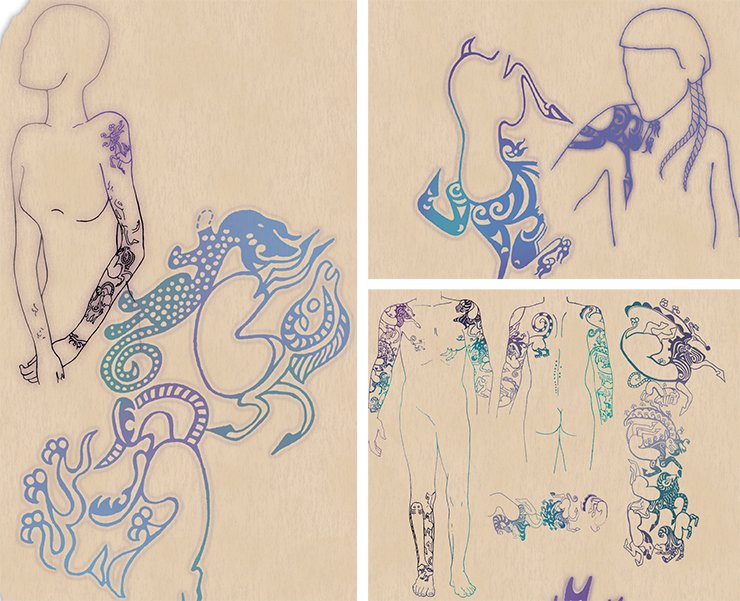The Pazyryk Culture
One of the discoveries which has amazed the world is the 2,500 year old mummy of the Ukok Princess, found in 1993 by scientist Natalia Polosmak during an archeological expedition. The princess was about 25 years old at the moment of her death and has been preserved in the Siberian permafrost. The culture of the Pazyryks says that the tattoos were a form of identification, such as a passport is now-a-days and, also, it meant that the person would be recognized by his or her family in the afterlife. Some say that, due to the discovery of an older man, from the same culture, with his body full of tattoos, and noticing that the princes had only two arms tattooed, these may also suggest the age of a person. Along with the princess, there were two other men found buried a few feet from her grave which are supposed to be warriors, them too having significant tattoos on their bodies.
In the Altay Mountains of Siberia there have been several other discoveries of tattooed mummies which are believed to have belonged to the Pazyryk Culture. These corpses were found in a series of tombs which have been preserved also in the permafrost. The intricate tattoos which were found on the skin of these corpses depicted both mythical and real animals, most of them in middle action, either running, stalking victims or twisted in an S shape which is known as the ‘pose of agony’. The most common animal which was used as a tattoo is described by Russian archaeologist Sergey Yatsenko as some sort of wild goat with an eagle beak and a panther tail and it is known to appear mostly on the right shoulder of mummies. On the left shoulder, the most popular tattoo is that of a tiger or wild ram, on the forefingers noblemen a rooster was positioned always ready for battle and on their legs groups of goats or rams usually accompanied them everywhere.
Even though most of the people in the Pazyryk Culture were heavily tattooed, Greek notes from that period state that this group almost never went out in public naked or even semi-naked, so the logical conclusion is that others would rarely notice the tattoos on one’s body and are believed to have been more for one’s personal record more than to show of.
Ötzi the Iceman
Ötzi is the name which has been given to a 5000 year old mummy that was discovered in the Ötztal Alps, hence the nickname, on the border of Italy and Austria. This mummy was discovered in 1991 on September 19th by two German tourists from Nuremberg. After the careful inspection of the mummy, several tattoos have been discovered on different parts of the body. These tattoos represented, mostly, different parallel lines in places such as ankles, wrists, knees and even lower back, which has lead to believe that these tattoos served not as a symbol or decoration, but rather has a healing purpose. It has been speculated that Ötzi’s tattoos were related to pain relief treatments similar to acupuncture.
The Ancient Ibaloi Tribe
In the Philippines, an indigenous tribe known as the Ibaloi people are known to have mastered the art of mummification and tattooing, raising it to another level. During their lifetime, the Ibaloi people used tattoos as rewards for their accomplishments. Head-hunters were known to wear tattoos in form of lizards, snakes, scorpions, and centipedes which were known as omen animals, after every enemy defeated in battle. Tattoos such as geometric shapes, representing various symbols were found on different mummified corpses of this tribe representing various elements, mostly of the environment. It is believed that these tattoos were used to represent a person’s status in the society due to the fact that the older the person, the more tattoos it had. Today, people who trace their routes back to the ancient Ibaloi tribe decide to wear on their skin the symbols which were a source of pride during their ancestor’s time.
The Tarim Basin Mummies
One more amazing discovery in the field of ancient tattoos comes from the barren desert of Tarim Basin in Southern China. A corpse belonging to a woman who is believed to have lived between 1000 and 600 B.C. was discovered somewhere outside the now modern village of Zaghuniuq. The woman was wearing her hair braided and tied with a red wool string and had her eyebrows painted just before her death, which lead to be believed that she had been sacrificed and then buried. The woman’s tattoos are believed to be ornamental or symbolic but at the same time unique. She had moons on her eyelids, ovals on her forehead and a decorative scroll pattern on her left hand all the way to her exceptionally long fingers. Such tattoos could not be related to any other tattoos known in the Russian culture and so, they stand as evidence to the fact that this form of art may have started more than 5000 years ago.

